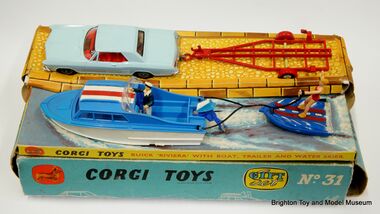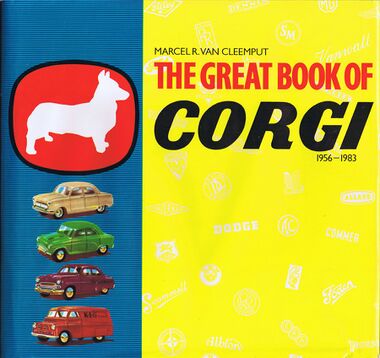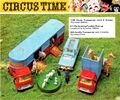Category:Corgi Toys
| Toy Brands and Manufacturers |
|---|
Corgi Toys |
| 1956 - |
1960: "Ford Zephyr Motorway Patrol" police car, Corgi Toys model 419, marking the recent opening of Britain's first Motorway, the M1, in 1959 [image info]
Buick Riviera Water Skier set, Gift Set 31 [image info]
1970: The Corgi Story [image info]
The Great Book of Corgi", by Marcel Van Cleemput [image info]
The Corgi Model Club, 1970 [image info]
Corgi Toys, by David Cooke (available through the Museum Shop) [image info]
The popular "Corgi Toys" brand of diecast model cars and other wheeled road vehicles) was launched in 1956 by Mettoy-Playcraft, and quickly became one of Britain's leading toy brands.
Naming
The name "Corgi Toys" sounded distinctly reminiscent of "Dinky Toys", and while the name couldn't be mistaken for that of their more established competitor, the similarity of the name did signal that Corgi were aiming at the Dinky market.
While "dinky" meant "small", corgis were also associated with smallness (the Welsh corgi breed of dog is notably short-legged), corgis also have a royal association (the Queen famously owns some), and since the breed is Welsh, the name was also a reference ot the company's new factory in Wales.
Mettoy later used another Welsh name reference when they got into the home computer market many years later with the Dragon 32.
Corgi Toys vs Dinky Toys
By the 1950s, Meccano may have become somewhat complacent about the success of their Dinky Toys range, which had been introduced in the 1930s and which had had almost no significant UK competition. While companies such as Britains Ltd. had perfected lead-casting, the lead-casting making companies hadn't moved with the times and invested in new alloys and processes required to make good diecast toy cars. Meccano Ltd had done this (embracing the initially-problematic MAZAC alloy) and reaped the benefits, producing a range of hundreds of well-designed wheeled toys which made it difficult for smaller companies to enter the market. However, by the mid-Fifties a number of their larger competitors were enviously eyeing Meccano Ltd.'s market share and making plans, the first of these to make their move being Mettoy.
Mettoy, like Meccano Ltd., had a background in metal toymaking but their big advantage was that they chose to enter the market with the added advantage of a further generation of manufacturing technology - plastics. Mettoy's stroke of management genius in avoiding getting too "set in their ways" was to set up a completely separate company (Playcraft Ltd.) to manufacture plastic toys. Without their metal-fabricating colleagues looking over their shoulders, Playcraft was able to experiment and explore the new materials and establish an expertise in plastics manufacturing and processes, and when Mettoy's Arthur Katz considered Playcraft to be a mature company, he fused the two companies to produce Mettoy-Playcraft, with both sets of skills combining to produce The "Corgi Toys" Car.
"The Ones with Windows"
Rooted in the 1930's Dinky Toys had always had all-metal bodyshells with holes for windows, and the company's difficult experiences with early diecasting had led them toward a "safe" company style in how they interpreted car bodyshapes that was perhaps a little "clunky". Dinky's customers didn't seem to care until they saw Corgi's new next-generation products, which had more delicate lines and plastic inserts to produce coloured moulded seating and steering wheels, and clear windows.
Corgi's technical advantage was brutally driven home by their marketing slogan "The Ones with Windows", and suddenly the existing range of Dinky Toys started to look a little dated. Although Dinky updated some models and replaced others with new "windowed" designs, it took a while for them to respond to the Corgi intrusion into what had been a comparatively uncompetitive market.
New-era packaging
Corgi's use of plastics didn't stop with adding "windows" to their cars – they also added them to their boxes! While Dinky Toys had originally been sent to retailers in boxes of six and then sold loose, and then had been increasingly sold in individual cardboard boxes, Corgi created cutouts on their boxes, glazed over with clear plastic film so that the cars could be seen, exposed, behind shiny individual windows on the toyshop shelves. Corgi's packaging designers continued to "think outside the box" with designs that sometimes included header panels and side panels and a range of other presentational gimmicks that made the products seem more glamorous and desirable, and which made the act of unboxing a Corgi car for the first time a more exciting experience.
Competitors
Dinky's woes didn't end with the appearance of Corgi, as toy manufacturing giant Lines Brothers also had plastics capability through their ownership of Rovex Plastics, and soon brought out Spot-On their own competitor to Dinky and Corgi, again with a huge range and with windows, but with a fractionally larger nominal scale (1:42 rather than 1:43) and promotional material emphasising their superior fidelity. Although Lines Brothers killed off their own Spot-On range when they acquired Meccano Ltd. (and Dinky Toys), the market soon found itself also hosting Lledo models, Matchbox, and Mattel's 1:64-scale Hot Wheels, whose smaller, lighter models and low-friction axles allowed their cars to be skidded across hard schoolroom floors to provide a different sort of play.
In the museum:
The museum has the Glenn Butler collection of around three hundred and fifty mint and boxed Corgi Toys (with packaging), almost all of which are in Arch Two.
A second Corgi display cabinet was added in January 2015.
See also:
Books
- David Cooke, Corgi Toys (Shire Library) ISBN 0747806675
- Marcel R.Van Cleemput and Allen Levy (ed) The Great Book of Corgi, 1956-1983 (New Cavendish, 1989) ISBN 0904568539
- Marcel R.Van Cleemput, The New Great Book of Corgi, 1956-2010 (2010) ISBN 1904562108
External links
Subcategories
This category has the following 4 subcategories, out of 4 total.
Pages in category ‘Corgi Toys’
The following 33 pages are in this category, out of 33 total.
B
C
- Carrimore car transporter gift set 41 (Corgi)
- Chipperfields Circus Animal Cage (Corgi 1123)
- Chipperfields Circus Crane Truck (Corgi 1121)
- Chipperfields Horse Transporter (Corgi 1130)
- Circus Giraffe Transporter (Corgi 503)
- Coop Scammell Transporter set (Corgi Major 1151)
- Corgi dog holding sign, retailer promotional display model (Corgi Toys)
- Corgi dog, small promotional models (Corgi Toys)
- Corgi Toys by Year
F
G
J
L
M
Media in category ‘Corgi Toys’
The following 50 files are in this category, out of 50 total.
- 100 Years of Flight (Corgi 2003).jpg 3,000 × 797; 574 KB
- A Merry Christmas from Corgi Toys, promotional model dog (Corgi Toys).jpg 2,200 × 1,467; 1.19 MB
- A Merry Christmas from Corgi Toys, promotional model dog, close (Corgi Toys).jpg 1,467 × 2,200; 1.24 MB
- Aurora Knights, Corgi Toys, Playcraft Ltd (Hobbies 1959).jpg 1,200 × 796; 461 KB
- Bassett-Lowke Van, Days Gone (Corgi DG043048).jpg 800 × 460; 252 KB
- Batmobile and Batboat Set, Corgi Toys 267 and 107 (CorgiCat 1970).jpg 1,800 × 1,131; 326 KB
- Batmobile and Batboat, Corgi Toys 267 and 107 (CorgiCat 1968).jpg 2,000 × 1,558; 478 KB
- Batmobile with packaging (Corgi 267).jpg 2,653 × 1,767; 1.47 MB
- Batmobile, box art (Corgi 267).jpg 3,000 × 1,217; 855 KB
- Beatles Yellow Submarine diecast toy, Corgi Toys 803 (CorgiCat 1970).jpg 1,200 × 930; 187 KB
- Carrimore Car Transporter, Corgi Toys 1138 (CorgiCat 1968).jpg 2,000 × 1,523; 689 KB
- Chitty Chitty Bang Bang 266 (CorgiCat 1970).jpg 1,459 × 1,800; 348 KB
- Circus Time, Chipperfields Circus, Corgi Toys (CorgiCat 1968).jpg 2,000 × 1,530; 694 KB
- Circus Time, Chipperfields Circus, page22 (CorgiCat 1970).jpg 1,600 × 1,330; 1.87 MB
- Circus Time, Chipperfields Circus, page23 (CorgiCat 1970).jpg 1,600 × 1,330; 1.62 MB
- Corgi Toys display spaces.jpg 800 × 1,200; 800 KB
- Corgi Toys logo (AirfixMag 1960-08).jpg 1,844 × 453; 409 KB
- Corgi Toys logo, 1970.jpg 2,735 × 574; 148 KB
- Corgi Toys, David Cooke, 0747806675 (Shire Library).jpg 849 × 1,200; 167 KB
- Corgi Toys, logo (~1962).jpg 1,800 × 716; 136 KB
- Ford Zephyr Motorway Patrol police car, Corgi Toys (AirfixMag 1960-08).jpg 2,075 × 3,000; 2.44 MB
- Green Hornet Black Beauty car Corgi Toys 268 (CorgiCat 1968).jpg 2,000 × 769; 339 KB
- Green Hornet Black Beauty car, Corgi Toys 268 (CorgiCat 1970).jpg 1,200 × 1,077; 205 KB
- Green Hornet Black Beauty, box art 01 (Corgi 268).jpg 3,000 × 1,224; 811 KB
- Green Hornet Black Beauty, box art 02 (Corgi 268).jpg 3,000 × 1,232; 734 KB
- James Bond Aston Martin DB5, above (Corgi 261).jpg 3,000 × 1,503; 355 KB
- James Bond Aston Martin DB5, angle (Corgi 261).jpg 3,000 × 1,497; 319 KB
- James Bond Aston Martin DB5, Corgi 270 (Glenn Butler Collection).jpg 2,000 × 1,334; 413 KB
- James Bond Aston Martin DB5, Corgi Toys 270 (CorgiCat 1968).jpg 2,000 × 1,248; 393 KB
- James Bond Aston Martin DB5, Corgi Toys 270 (CorgiCat 1970).jpg 1,024 × 634; 144 KB
- James Bond Aston Martin DB5, packaging (Corgi 261).jpg 3,000 × 1,199; 480 KB
- James Bond Aston Martin DB5, side (Corgi 261).jpg 3,000 × 1,200; 396 KB
- James Bond Cars, Corgi Toys (CorgiCat 1968).jpg 2,000 × 1,505; 748 KB
- James Bond Lotus gift set, Corgi Juniors (Collectors Market).jpg 800 × 534; 281 KB
- James Bond Toyota 2000, Corgi Toys 336 (CorgiCat 1968).jpg 2,000 × 1,069; 301 KB
- La France Fire Rescue Truck, Corgi Toys 1143 (CorgiCat 1968).jpg 2,000 × 1,506; 743 KB
- Man from Uncle, Thrushbuster, Corgi Toys 497 (CorgiCat 1968).jpg 2,000 × 824; 304 KB
- Monkeemobile, Corgi Toys 277 (CorgiCat 1970).jpg 1,200 × 1,033; 218 KB
- Monkees Monkeemobile, Corgi Toys 277 (CorgiCat 1968).jpg 2,000 × 815; 314 KB
- Riviera Water Skier Set, Corgi Toys gift Set 31.jpg 3,000 × 1,688; 720 KB
- Simon Snorkel Fire Engine, Corgi Toys 1127 (CorgiCat 1968).jpg 2,000 × 1,497; 440 KB
- Southdown Bedford OB coach JCD 370, side (Corgi Original Omnibus 42607).jpg 1,800 × 1,010; 612 KB
- The Avengers, Corgi Toys (CorgiCat 1968).jpg 2,000 × 725; 328 KB
- The Beatles Yellow Submarine, Corgi Toys 803 (CorgiCat 1968).jpg 2,000 × 1,525; 753 KB
- The Corgi Model Club (CorgiCat 1970).jpg 1,097 × 1,800; 444 KB
- The Corgi Story (CorgiCat 1970).jpg 2,000 × 1,643; 1,016 KB
- The Great Book of Corgi, ISBN 0904568539, front cover.jpg 1,200 × 1,130; 231 KB
- The Saint Volvo P1800, Corgi Toys 258 (CorgiCat 1968).jpg 1,774 × 1,256; 481 KB
- The Space Race (Corgi 2003).jpg 1,544 × 2,500; 576 KB
- Wright Flyer (Corgi Toys AA34503).jpg 1,024 × 683; 380 KB
















































